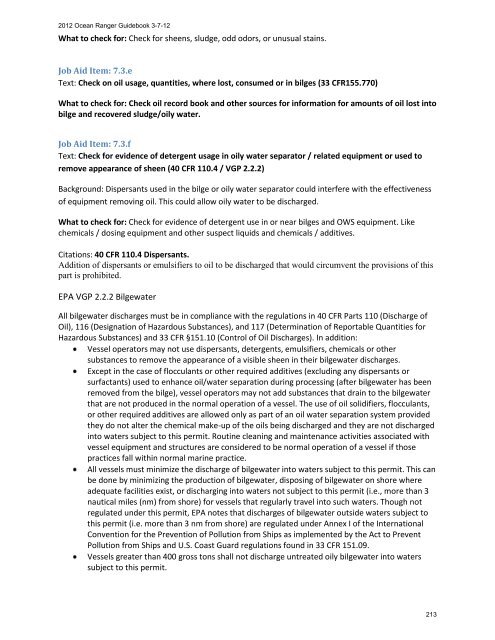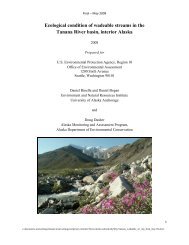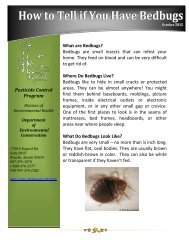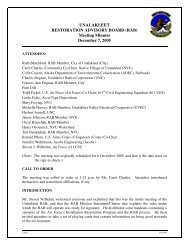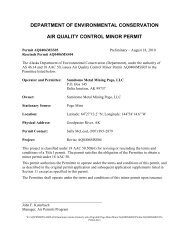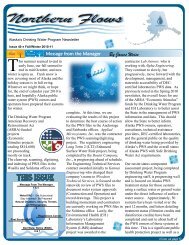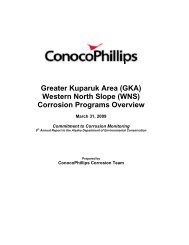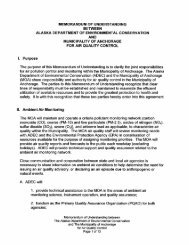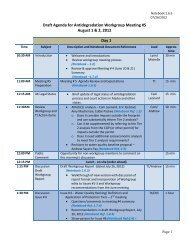2012 Ocean Ranger Guidebook Revision 3-7-12 - Alaska ...
2012 Ocean Ranger Guidebook Revision 3-7-12 - Alaska ...
2012 Ocean Ranger Guidebook Revision 3-7-12 - Alaska ...
Create successful ePaper yourself
Turn your PDF publications into a flip-book with our unique Google optimized e-Paper software.
<strong>20<strong>12</strong></strong> <strong>Ocean</strong> <strong>Ranger</strong> <strong>Guidebook</strong> 3-7-<strong>12</strong><br />
What to check for: Check for sheens, sludge, odd odors, or unusual stains.<br />
Job Aid Item: 7.3.e<br />
Text: Check on oil usage, quantities, where lost, consumed or in bilges (33 CFR155.770)<br />
What to check for: Check oil record book and other sources for information for amounts of oil lost into<br />
bilge and recovered sludge/oily water.<br />
Job Aid Item: 7.3.f<br />
Text: Check for evidence of detergent usage in oily water separator / related equipment or used to<br />
remove appearance of sheen (40 CFR 110.4 / VGP 2.2.2)<br />
Background: Dispersants used in the bilge or oily water separator could interfere with the effectiveness<br />
of equipment removing oil. This could allow oily water to be discharged.<br />
What to check for: Check for evidence of detergent use in or near bilges and OWS equipment. Like<br />
chemicals / dosing equipment and other suspect liquids and chemicals / additives.<br />
Citations: 40 CFR 110.4 Dispersants.<br />
Addition of dispersants or emulsifiers to oil to be discharged that would circumvent the provisions of this<br />
part is prohibited.<br />
EPA VGP 2.2.2 Bilgewater<br />
All bilgewater discharges must be in compliance with the regulations in 40 CFR Parts 110 (Discharge of<br />
Oil), 116 (Designation of Hazardous Substances), and 117 (Determination of Reportable Quantities for<br />
Hazardous Substances) and 33 CFR §151.10 (Control of Oil Discharges). In addition:<br />
Vessel operators may not use dispersants, detergents, emulsifiers, chemicals or other<br />
substances to remove the appearance of a visible sheen in their bilgewater discharges.<br />
Except in the case of flocculants or other required additives (excluding any dispersants or<br />
surfactants) used to enhance oil/water separation during processing (after bilgewater has been<br />
removed from the bilge), vessel operators may not add substances that drain to the bilgewater<br />
that are not produced in the normal operation of a vessel. The use of oil solidifiers, flocculants,<br />
or other required additives are allowed only as part of an oil water separation system provided<br />
they do not alter the chemical make-up of the oils being discharged and they are not discharged<br />
into waters subject to this permit. Routine cleaning and maintenance activities associated with<br />
vessel equipment and structures are considered to be normal operation of a vessel if those<br />
practices fall within normal marine practice.<br />
All vessels must minimize the discharge of bilgewater into waters subject to this permit. This can<br />
be done by minimizing the production of bilgewater, disposing of bilgewater on shore where<br />
adequate facilities exist, or discharging into waters not subject to this permit (i.e., more than 3<br />
nautical miles (nm) from shore) for vessels that regularly travel into such waters. Though not<br />
regulated under this permit, EPA notes that discharges of bilgewater outside waters subject to<br />
this permit (i.e. more than 3 nm from shore) are regulated under Annex I of the International<br />
Convention for the Prevention of Pollution from Ships as implemented by the Act to Prevent<br />
Pollution from Ships and U.S. Coast Guard regulations found in 33 CFR 151.09.<br />
Vessels greater than 400 gross tons shall not discharge untreated oily bilgewater into waters<br />
subject to this permit.<br />
213


